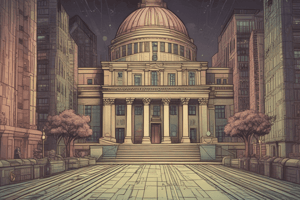Podcast
Questions and Answers
What is the primary goal of expansionary monetary policy?
What is the primary goal of expansionary monetary policy?
- To control the money supply
- To increase inflation rates
- To fuel economic growth (correct)
- To reduce unemployment
A high level of inflation is considered healthy for the economy.
A high level of inflation is considered healthy for the economy.
False (B)
What can monetary policies influence in the economy?
What can monetary policies influence in the economy?
Money supply and inflation levels
A contractionary monetary policy aims to decrease the __________ in the economy.
A contractionary monetary policy aims to decrease the __________ in the economy.
Which of the following is NOT a method of achieving contractionary monetary policy?
Which of the following is NOT a method of achieving contractionary monetary policy?
Increasing the required reserves for banks makes more money available for lending.
Increasing the required reserves for banks makes more money available for lending.
What can be a disadvantage of low interest rates during a recession?
What can be a disadvantage of low interest rates during a recession?
Match the following monetary policy outcomes with their effects:
Match the following monetary policy outcomes with their effects:
What effect does a rise in interest rates have on bond prices?
What effect does a rise in interest rates have on bond prices?
Inflation is easier to control than deflation.
Inflation is easier to control than deflation.
What was Keynes' belief regarding government intervention in the economy?
What was Keynes' belief regarding government intervention in the economy?
During deflationary periods, central banks may reduce their policy rates to as low as _____ to stimulate the economy.
During deflationary periods, central banks may reduce their policy rates to as low as _____ to stimulate the economy.
What can render an expansionary monetary policy ineffective during periods of decreased money supply?
What can render an expansionary monetary policy ineffective during periods of decreased money supply?
Match the following concepts with their explanations:
Match the following concepts with their explanations:
What do bond market vigilantes do?
What do bond market vigilantes do?
In Keynesian economics, _____ is what drives the performance and growth of the economy.
In Keynesian economics, _____ is what drives the performance and growth of the economy.
What characterizes expansionary fiscal policy?
What characterizes expansionary fiscal policy?
Contractionary fiscal policy aims to lower inflation by increasing government spending.
Contractionary fiscal policy aims to lower inflation by increasing government spending.
What does fiscal policy refer to?
What does fiscal policy refer to?
During a recession, the government may lower ______ to encourage economic activity.
During a recession, the government may lower ______ to encourage economic activity.
What can uncertainty about how the economy reacts to expansionary monetary policy lead to?
What can uncertainty about how the economy reacts to expansionary monetary policy lead to?
Deficit spending occurs when government expenditures exceed receipts from taxes.
Deficit spending occurs when government expenditures exceed receipts from taxes.
What do central banks attempt to manipulate within an economy?
What do central banks attempt to manipulate within an economy?
Match the following types of fiscal policy with their goals:
Match the following types of fiscal policy with their goals:
What is one effect of the central bank purchasing government securities?
What is one effect of the central bank purchasing government securities?
Selling government securities by the central bank increases the amount of money circulating in the economy.
Selling government securities by the central bank increases the amount of money circulating in the economy.
What is the role of the central bank during financial crises?
What is the role of the central bank during financial crises?
Increasing the __________ requirements means banks must hold a larger proportion of their deposits as reserves.
Increasing the __________ requirements means banks must hold a larger proportion of their deposits as reserves.
Which of the following tools is often used to curb inflation?
Which of the following tools is often used to curb inflation?
Decreasing reserve requirements leads to a contraction in lending and a reduced money supply.
Decreasing reserve requirements leads to a contraction in lending and a reduced money supply.
Match the following actions of the central bank with their impacts:
Match the following actions of the central bank with their impacts:
What typically happens to interest rates when the central bank buys government securities?
What typically happens to interest rates when the central bank buys government securities?
The value of money is solely determined by the number of goods and services it can purchase.
The value of money is solely determined by the number of goods and services it can purchase.
List the three motives behind the demand for money according to Keynes.
List the three motives behind the demand for money according to Keynes.
According to Fisher's quantity theory, the formula is MV = ______.
According to Fisher's quantity theory, the formula is MV = ______.
Match the following terms with their descriptions:
Match the following terms with their descriptions:
If M = 1,000,000, K = 1/6, and T = 12,000,000, what will be the price level P?
If M = 1,000,000, K = 1/6, and T = 12,000,000, what will be the price level P?
If the demand per money (K) is increased to 1/3, the price level (P) will increase.
If the demand per money (K) is increased to 1/3, the price level (P) will increase.
What assumption does Keynes make about individuals in the quantity theory approach?
What assumption does Keynes make about individuals in the quantity theory approach?
Flashcards are hidden until you start studying
Study Notes
Monetary Policy
- Monetary policy is the central bank’s actions to manipulate the money supply and credit conditions to influence macroeconomic variables like inflation, unemployment, and economic growth.
- There are two main types of monetary policy:
- Expansionary monetary policy aims to stimulate the economy by increasing the money supply and lowering interest rates.
- Contractionary monetary policy aims to slow economic growth and curb inflation by decreasing the money supply and raising interest rates.
- Expansionary monetary policy is pursued during periods of economic weakness or recession, while contractionary monetary policy is used during times of high inflation.
Tools of Monetary Policy
- Central banks use several tools to implement monetary policy:
- Open market operations: The central bank buys or sells government securities in the open market to inject or remove money from the banking system.
- Reserve requirements: The central bank sets the minimum percentage of deposits that commercial banks must hold in reserve.
- Discount rate: The central bank sets the interest rate at which it lends money to commercial banks, known as the discount rate.
- Inflation targeting: Some central banks adopt an explicit inflation target, which serves as a guide for monetary policy actions.
Impact of Monetary Policy
- Monetary policy can have both positive and negative impacts on the economy:
- It can help mitigate the effects of business cycles by stimulating growth during recessions and slowing down inflation during booms.
- It can also be used to manage exchange rates and promote financial stability.
- However, monetary policy can be complex and its effects can be unpredictable, especially in the short run.
Keynesian Theory of Money
- Keynes believed that government spending and taxation could be used to stabilize the business cycle.
- His theory was developed in response to the Great Depression, and it challenged the classical economics assumption that economic swings were self-correcting.
- Keynes argued that aggregate demand is a key driving force of the economy.
- Aggregate demand is composed of:
- Consumer spending
- Business investment spending
- Net government spending
- Net exports
Fiscal Policy
- Fiscal policy refers to the use of government spending and taxes to influence economic conditions.
- Expansionary fiscal policy involves deficit spending, where government expenditures exceed receipts from taxes and other sources.
- Contractionary fiscal policy involves reducing deficit spending, raising taxes, or both.
- The goal of expansionary fiscal policy is to stimulate economic activity, while contractionary fiscal policy aims to slow down inflation.
Quantity Theory of Money
- This theory relates price levels to the quantity of money in circulation.
- Formula: M = PKT where:
- M = Money Supply
- P = Price Level
- T = Total Volume of Transactions
- K = Demand for Money (per transaction)
- This theory suggests that if the money supply increases faster than real GDP, the price level will rise.
- The quantity theory of money is a long-run theory, and it may not hold true in the short run.
Demand for Money
- Keynes argued for three motives behind the demand for money:
- Transactions Motive: To carry out everyday transactions.
- Precautionary Motive: To meet unexpected or emergency needs.
- Speculative Motive: To profit from expected changes in interest rates or bond prices.
Studying That Suits You
Use AI to generate personalized quizzes and flashcards to suit your learning preferences.




